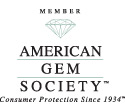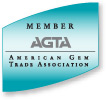“Deacquisitioning” Gems- A Mardon Specialty
January 14th, 2012 by James L. Sweaney, CGA, FGA. GGJust in time for Christmas, we completed a very interesting and successful sale for a client who had found us via the Internet last spring. She had purchased this wonderful 5.72 ct. Paraiba tourmaline in the early 90’s, just when the first stones from the Paraiba region of Brazil were coming onto the market.
Prices of Paraiba stones quickly skyrocketed, especially since this small deposit was soon mined out. Collectors and aficionados realized the rarity and uniqueness of these gems and began paying astronomical prices for the best material. The “Electric” blues can sell today for six figures per carat!
When she asked me to sell the stone for her, my experience with fine gems told me it would a challenge, for a couple of reasons.
First, the preferred color of Paraiba tourmalines is the vivid slightly greenish blue sometimes called “Electric” or “Neon.” The not-so-grand trade description “Windex” captures the color perfectly.
While her stone had all the attributes collectors look for– large size, flawless clarity, great cut, rarity, and a wonderful vivid slightly bluish green color, it was not that unique blue color that collectors lust for. So we would have to find just the right buyer.
The other issue was the origin. Discoveries of similar copper bearing tourmalines in Nigeria in 2001 and Mozambique in 2004 brought a good supply of new stones onto the market– similar colors but most were not as rich and vivid as the original Paraiba find and certainly not as rare– limited production from Mozambique continues to this day.
Because of the fame the Paraiba material had so quickly attained, the name became a buzz word that was used to market this new African material. Controversy still exists today, but has largely been settled by a bifurcated market, where cuprian tourmalines from Africa sell for one price, stones proven to be from the original Paraiba find selling for substantially higher prices.
I knew from the dates on her original sales documents that the stone was indeed Paraiba. To get the price that this ultra rare beauty deserved, we would have to prove it’s Brazilian origin, so we sent the stone to GIA for this proof of origin document.
We worked with our contacts within the Gem Trade, even going so far as to show the stone at the fall Hong Kong show. With patience and perseverance, we were able to sell the stone and pay her a 425% return over what she had purchased it for– not a bad return for a 20 year investment!
My client’s gem investment was certainly timely– but the important thing was that she bought quality. Fine rare gems can be an excellent investment, but choosing the right stone is the key. Like any investment, luck and timing are also in the mix. She worked with an expert jeweler, bought what she loved, paid a fair retail at the time, and was able to enjoy owning a true treasure until she was ready to sell.
You can read her testimonial on our Testimonials page– It’s the first one at the top of the page.
With our many contacts within the gem trade, we can find good buyers for vintage jewelry, colored gems and diamonds of quality– give us a call if you are ready to “deaquisition.”
Tags: gem broker, Mozambique, Nigeria, paraiba tourmaline, Vintage Jewelry









